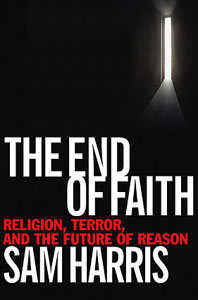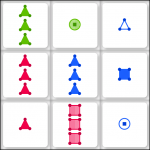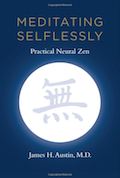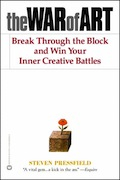From an ongoing discussion with a fellow I randomly met at a restaurant, who had overheard a philosophical conversation I was having with my brother:
I think that God cannot be understood rationally, through logic. Logic can only “point at” God in a completely inadequate way, such as the words “the moon” point to the actual moon, or “anger” points to an emotion of anger. If you have not experienced anger, then the word means little to you. If you were an alien and saw humans being angry at each other, then you might build some kind of logical model for the causes of anger and what it does to an organism that is in a state of anger, but you would not know anger, you would just know about it. Certain things you need to experience for them to really be meaningful.
So I think that we have made models about God, but that they are even less adequate towards understanding the experience of God than “anger” is towards understanding the experience of anger, or “the color blue” is towards understanding the experience of the color blue. Similarly, radio waves are just part of the electromagnetic spectrum. If we could “see” radio waves or X-rays, we would see some other “color” we can’t conceptualize, but we’re limited towards a scientific (model) understanding of it.
So we build models about God, yes. Where do they come from? They come from rare individuals’ actual experiences with different kinds of perception. It seems clear to me now that at key moments in history, individuals’ brains became wired a little bit differently, or something shifted, and they were able to experience directly something which is barely even hinted at by the words surrounding the experience, anymore. Were they actually experiencing God, or merely a part of themselves? Diverse traditions which spring up around these experiences differ vastly. For example, there is the Buddhist concept of “enlightenment”, where the Buddha himself was an ordinary man who, through years of meditation and asceticism achieved what is almost directly described as an altered mental state, a different brain wiring. It seems clear that Jesus also had radical change-of-consciousness experiences, as did other figures in the past. Mind-altering substances often also played a great role in inducing these states older civilizations (e.g. the Eleusinian Mysteries), when found in their natural forms, and do often achieve these states in the present. [The conservative forces (that is, the normal culture) of society deemed such experimentation, when these substances were not already part of the culture, extremely dangerous in the 60’s and reactively outlawed substances like LSD with extremely harsh penalties– not because that substance itself was particularly dangerous or physiologically harmful, but because used widely it facilitated a kind of self-transcendent experience that led to a radical social movement where individuals were questioning, casting aside the strictures of society (that is, their “programming”) and “dropping out,” with groups (see hippies) not-quite-yet beginning to redefine and build up sustainable rules for themselves, or testing rules which made mainstream culture uncomfortable.]
- Zen and the Brain by James Austin.
- Nothing Sacred: The Truth about Judiasm by Douglas Rushkoff (about Judaism, but takes a human-centered viewpoint on the origins and purpose of the religion, and the definition of God).
- Prometheus Rising by Robert Anton Williams (also freely available on the Web as a PDF; I just finished and highly recommend this one).
I also recommend seriously attempting meditation and giving it a chance, to see if there is “anything there” for you. After a very small amount of progress I can understand the greater progress that those who have devoted very great amounts of time to it. It is not something that can be explained in words, just like “blue” cannot be explained.
Ask yourself the question: “Who is the one who is living me now?” constantly, and try to focus deeply on experiencing the answer, not just through your logic, but through direct experience.
Regarding meaning, purpose, programming, et cetera: we are programmed by society around us. Prometheus Rising attempts to explain this. As human beings we have a particular “reality tunnel” as a species. This and our individual reality tunnels are what lead us to picking those things which give us meaning and purpose. Because our reality tunnel is not that much different from that of our parents, you can visualize humanity as “growing” like a giant complex plant on the planet.
Regarding what is real: the universe is empty without us, just like there is no color blue without us. Wavelengths exist (but not at all as we conceive them), but no color, no sound, no smell, no thought. Therefore every being creates these things for itself. You create the color blue by seeing. Does that make you God?
There is objective reality but it is meaningless; we create meaning. The same goes for more complicated concepts, like all ideas, or the idea of God, which is ultimately an abstract model. Does that make sense? Without humans, there is no God. We create God in our own minds, when we create the model, like we create blue.
[ Maybe “experiencing God” is experiencing the process of creation itself more directly as it exists in our own minds. ]
What is it a model of? What’s the objective reality? Keep in mind that you can think anything you want. There are a lot of ideas out there. You can imagine the earth balanced on the back of a giant sticky ten-legged frog standing on a lilly pad floating in space. Then you can imagine that the frog is invisible, or whatever you want to do in your mind. Does that make it real? The only way to know in a rational sense, is to test that model, somehow. Otherwise it’s “as good as” any religion’s model of God, but no more or less true.
Clearly people have experiences of the divine, of the infinite, of God, as real in these moments as “blue”. Does that mean they are perceiving what religion crudely depicts (for the rest of us) as God, or something else about the universe, something about its fundamental nature which we don’t ordinarily perceive? Or something about themselves? I think the religions which have sprung up around these experiences very quickly convert the actual experience into something blatantly inaccurate (and politically tainted), like a game of broken telephone. The biggest mistranslation by far occurs between the individual who had a mystical experience, and those surrounding him or her, because the experience can only vaguely be hinted at with language. Thus, the major religions of the world each tell us nothing about God besides giving us an untestable and crude model, which somehow has the people following it in its thrall, for both social reasons, and for reasons that we cannot (typically, in our society) understand because we have not had such experiences. These experiences (especially when they happen spontaneously) sometimes transform individuals who have them, in ways which make them charismatic (because surety is charismatic, and you are sure of your own experience). But again, language itself can barely touch these experiences, so the logical model constructed for transmission to others is pretty meaningless. Meta-study of the world’s religions (and all human experience, for that matter) would point us in the right direction, but again only in an “understanding wavelengths” way and not a “seeing blue” way.
Regarding free will: as I’ve said, it’s not something we can conceptualize. Free will versus determinism is like quantum mechanics versus large-scale behaviors. Everything can be modeled deterministically except at the lowest level, where the “particles” of choice seem to be unpredictable. When you think of another person deciding something, you can make a model to predict what that person will do. As accurate as your model is, you come to a point where whether the person will do something or not do something, when it’s right on the line, needs to be represented as a probability.
When you think about yourself, you are actually thinking about a model of yourself, not running your actual self. You have a model of yourself in your thoughts, and you run the model, just like you run the models of others. Clearly you end up with the same types of uncertainty as when modeling other people. So you cannot conclude that you have anything other than “free will”, which just means that you cannot know what you or your “self” will do, just as you cannot know what anyone else will do.
With respect to the universe itself, we build models of it, but we also cannot know what it will do, at the lowest level of our models (we can only resort to probabilities). Consider that our minds exist to perceive the universe and give meaning to it. (E.g., we create blue, which does not exist without us.) But we cannot fully model ourselves or each other, thus the necessary perception of having free will, regardless of whether it “really” exists or not. Does our own free will have anything to do with the apparent “free will” of the universe, the fact that we can’t pin down reality (at its lowest level) to anything other than probabilities?
I.e., in a probabilistic universe (such as one you simulated on a computer), could beings in it construct equipment to measure the deterministic behavior of its “fundamental particles”? Assuming that they could, then what would be the consequence(s) to them?
Assuming there were consequences, then it would make sense to “shield” the beings in the simulated probabilistic universe from being able to measure their own fundamental particles, by making the behavior of those particles random. (“Random” in what way? Using sampled natural data from the enclosing (e.g., “our”) universe?)
That’s something interesting to think about, for the time being.
 On
On 

 The solution to writer’s block? Lower your standards. I read that on the Web somewhere, and followed a series of links to a particular book on productivity at Amazon. The reviews for that book were lauding this one, by the same author, saying it should be read first. I was intrigued and ordered
The solution to writer’s block? Lower your standards. I read that on the Web somewhere, and followed a series of links to a particular book on productivity at Amazon. The reviews for that book were lauding this one, by the same author, saying it should be read first. I was intrigued and ordered